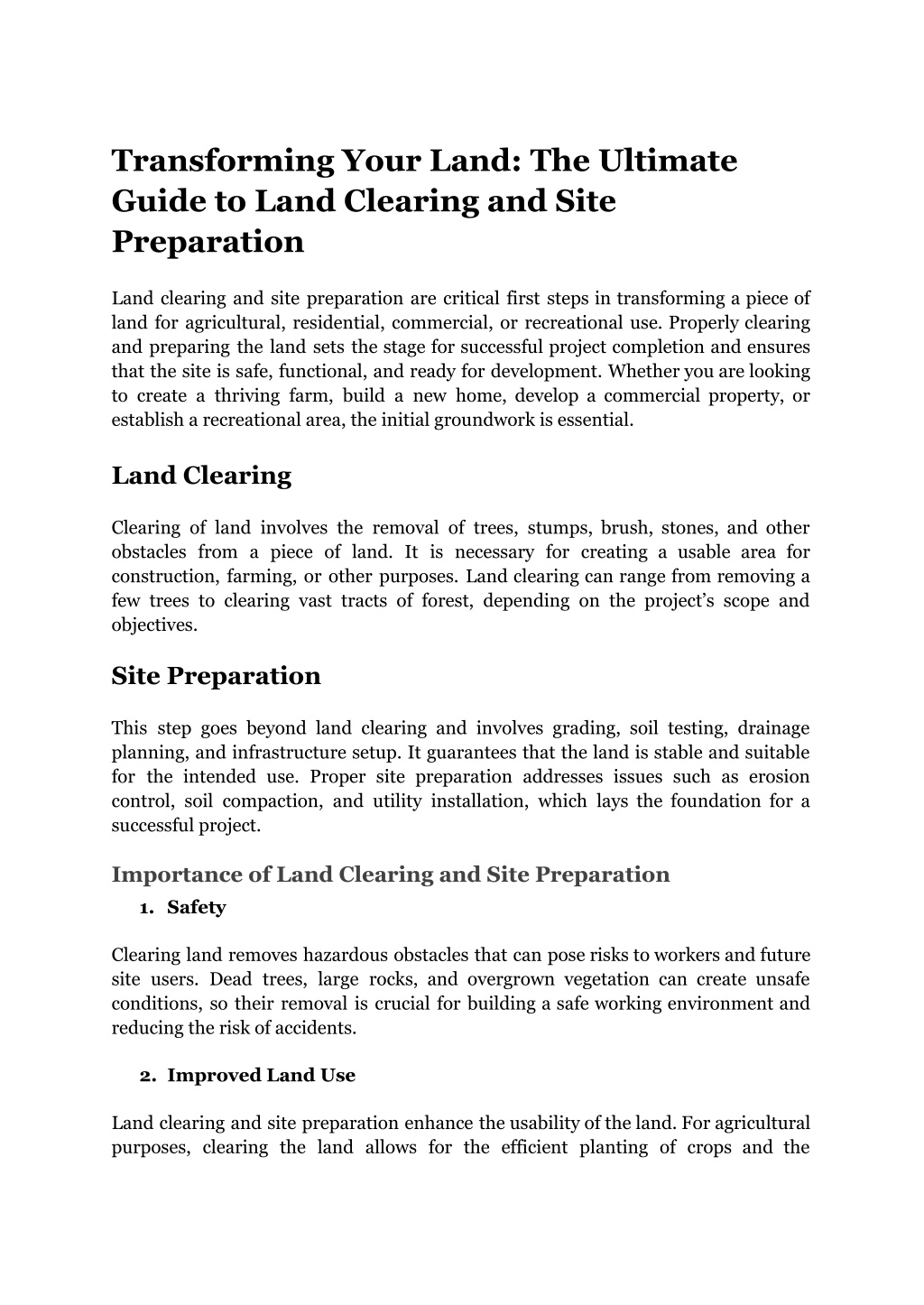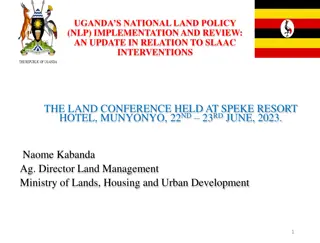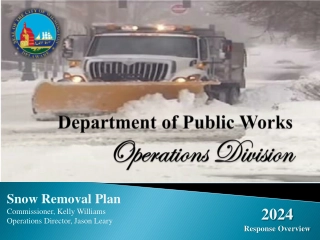
Transforming Your Land_ The Ultimate Guide to Land Clearing and Site Preparation
Grading necessitates reshaping the land to make it even and suitable for constructionnor agriculture. Helena excavating contractors fill low areas, cut high spots, andnguarantee proper drainage. Grading helps prevent water pooling and soil erosion,nthereby building a stable foundation for future development.
Download Presentation
Please find below an Image/Link to download the presentation.
The content on the website is provided AS IS for your information and personal use only. It may not be sold, licensed, or shared on other websites without obtaining consent from the author. Download presentation by click this link. If you encounter any issues during the download, it is possible that the publisher has removed the file from their server.
Presentation Transcript
Transforming Your Land: The Ultimate Guide to Land Clearing and Site Preparation Land clearing and site preparation are critical first steps in transforming a piece of land for agricultural, residential, commercial, or recreational use. Properly clearing and preparing the land sets the stage for successful project completion and ensures that the site is safe, functional, and ready for development. Whether you are looking to create a thriving farm, build a new home, develop a commercial property, or establish a recreational area, the initial groundwork is essential. Land Clearing Clearing of land involves the removal of trees, stumps, brush, stones, and other obstacles from a piece of land. It is necessary for creating a usable area for construction, farming, or other purposes. Land clearing can range from removing a few trees to clearing vast tracts of forest, depending on the project s scope and objectives. Site Preparation This step goes beyond land clearing and involves grading, soil testing, drainage planning, and infrastructure setup. It guarantees that the land is stable and suitable for the intended use. Proper site preparation addresses issues such as erosion control, soil compaction, and utility installation, which lays the foundation for a successful project. Importance of Land Clearing and Site Preparation 1. Safety Clearing land removes hazardous obstacles that can pose risks to workers and future site users. Dead trees, large rocks, and overgrown vegetation can create unsafe conditions, so their removal is crucial for building a safe working environment and reducing the risk of accidents. 2. Improved Land Use Land clearing and site preparation enhance the usability of the land. For agricultural purposes, clearing the land allows for the efficient planting of crops and the
management of fields. In construction, it provides a stable and level foundation for buildings, roads, and other infrastructure. 3. Environmental Benefits Proper land clearing can have environmental benefits, such as promoting the growth of desirable vegetation and preventing the spread of invasive species. Additionally, well-planned site preparation assists manage water runoff and reduces soil erosion, which eventually protects local ecosystems. Steps in Land Clearing and Site Preparation 1. Planning and Permitting Before beginning any land clearing project, excavators in Helena MT, conduct thorough planning. This includes assessing the land, defining the project s scope, and obtaining necessary permits. Local regulations may govern land clearing activities, so professionals comply with zoning laws and environmental regulations. 2. Surveying and Marking Surveying the land identifies property boundaries, existing structures, and natural features that need to be preserved. Marking these areas determines that clearing activities are confined to the designated space. This ultimately contributes to minimizing the likelihood of accidental damage to protected zones. 3. Selecting the Right Equipment The equipment used for land clearing depends on the project s size and complexity. Common machinery includes bulldozers, excavators, chainsaws, and mulchers. For large-scale projects, specialized equipment like forestry mulchers and stump grinders may be necessary. Selecting the appropriate equipment increases efficiency and effectiveness in clearing the land. 4. Removing Vegetation and Debris In the first phase of land clearing, Helena excavation service providers remove vegetation, such as trees, shrubs, and brush. This can be done manually or with machinery based on the density and type of vegetation. Additionally, large trees may need to be cut down to create a level surface. 5. Grading and Levelling Grading necessitates reshaping the land to make it even and suitable for construction or agriculture. Helena excavating contractors fill low areas, cut high spots, and
guarantee proper drainage. Grading helps prevent water pooling and soil erosion, thereby building a stable foundation for future development. 6. Soil Testing and Improvement Soil testing is a critical step in site preparation, particularly for agricultural and construction projects. Testing determines soil composition, pH levels, and nutrient content, which helps make decisions on soil improvement measures. Adding compost, fertilizers, or lime can enhance soil fertility and structure while making it more favorable for planting or building. 7. Implementing Drainage Solutions To avoid problems with water, like soil erosion and flooding, proper drainage is important. Installing drainage systems like French drains, culverts, and ditches makes sure that water is effectively managed and directed away from the site. This step plays a tremendous role in improving areas prone to heavy rainfall or with poor natural drainage. 8. Installing Utilities For construction projects, site preparation includes installing utilities such as water, sewer, electricity, and gas lines. Planning and laying out these utilities in advance avoids future disruptions and promises that the infrastructure is in place to support the development. 9. Erosion Control Erosion control measures, such as silt fences, erosion control blankets, and retaining walls, protect the site from soil loss and sediment runoff. These measures are paramount for sloped or hilly terrain, where erosion can be a significant issue. Implementing erosion control early in the site preparation process helps maintain soil stability and protect nearby water bodies. Conclusion Altering land through effective land clearing and site preparation is a crucial step in any development project. By understanding the importance of these processes and following best practices, landowners can ensure that their land is safe, functional, and ready for its intended use. At Schaefer Excavating & Construction, we offer the best Helena excavation services to help people prepare sites for construction purposes and accomplish optimal final results!
















































